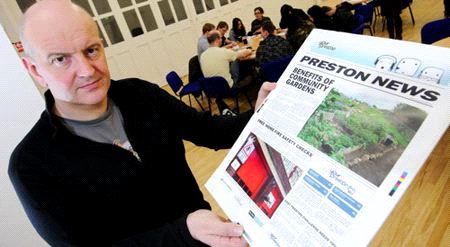Newspaper & Mailroom
Interactive Newsprint hailed at SxSW Festival

Tuesday 12. March 2013 - Preston-based project appears at world-famous South-by-South-West festival
UCLan’s Interactive Newsprint project connects touch-sensitive paper to the internet.
Research has produced ‘interactive’ prototypes with community and international publishers in the UK, and from Europe and South America.
Technology enables readers to listen to audio, vote and ‘Like’ content on the paper by simply touching it.
Project well received at SxSW panel ‘Pitchforks and Printed Electronics’ with international news website Worldcrunch.
Imagine traditionally printed paper that can connect to the internet, play audio, offer live ‘touch-voting’ and link with social media.
It might take the form of a poster or cereal packet that streams local radio right into your kitchen, or a newspaper that delivers your daily community news in audio form, or perhaps a map of world that provides the latest audio headlines from around the globe.
Over the last two years, ‘Interactive Newsprint’ – a research project led by the University of Central Lancashire (UCLan) and involving the University of Dundee, University of Surrey and technology partner Novalia – has explored a radical new media future: one that’s not based around touch screens and instead uses cutting-edge printed electronics to connect the web to standard, everyday paper.
Working with communities throughout Preston, the UK and internationally, the project has prototyped a host of different ‘interactive paper’ platforms that can detect human touch, play audio files, create voting points and upload and download information to the web.
Interactive Newsprint and Paris-based news website Worldcrunch have now gone international after presenting the latest prototype at the world-renowned technology, music and film festival, Southby-South-West (SxSW).
SxSW: Pitchforks and Printed Electronics
UCLan’s Paul Eggleston, the project lead investigator, Tom Metcalfe – designer and researcher at the University of Dundee – and Garrett Goodman of international news and information website Worldcrunch.com took to the festival stage to talk about the technology, its potential and how it might help communities to tell and receive content from around the globe.
Responses to the panel session were positive. American journalist Liz Treichler tweeted that the Interactive Newsprint project was the coolest thing she’d seen so far at South by South West whilst PR blogger Brian Block commented on Twitter: “This makes so much sense because it delivers digital news in a means familiar to the masses who aren’t online for news.”
Paul Eggleston, director of UCLan’s Media Innovation Studio, said: “It’s great to be at the world’s biggest and best interactive festival. ‘South by’ is the perfect place to show Interactive Newsprint.
“It’s always interesting turning up at digital festivals and surprising a few folk with what we’re doing. We love screen based tech – mobiles and tablets – but it’s not the only potential future for displaying news and information, especially when you consider that communities will be able to create this stuff themselves from scratch.”
The project’s latest collaboration with the media start-up Worldcrunch has produced an interactive global map that lets users to touch regions around the world to hear content taken from around the web, and then edited and translated by the Worldcrunch editorial team.
“There’s the potential to create a beautiful harmony between the finality of print, and the transient nature of news. Connecting paper and print to the internet can be incredibly powerful.”
Tom Metcalfe said: “There’s the potential to create a beautiful harmony between the finality of print, and the transient nature of news. Connecting paper and print to the internet can be incredibly powerful. We have taken these conversations to SX and challenged the idea that print isn’t yet dead!”
Jon Rogers, Interactive Newsprint lead researcher and director of the product research studio at the University of Dundee, added: “We’ve been working closely with our community members in Preston and now we’ve been able to put the ideas generated from this hyper-local community in front of the world’s thinkers and generators of the biggest technology ideas.
“What we love is that we think there is a very good chance that the people of Preston might have come up with the very next thing. The biggest idea, and most original thinking and the most radical concept for the future of news might very well have come from a community centre in Preston; not a brainstorming session at a technology giant.”
Worldcrunch’s Garrett Goodman said: “At Worldcrunch we are platform agnostic and platform curious! … And as such we were intrigued by the ways interactive print can highlight both the depth and breadth of our global content.”
“The biggest idea, and most original thinking and the most radical concept for the future of news might very well have come from a community centre in Preston; not a brainstorming session at a technology giant.”
Paper Data
In tandem with the physical designs, the team have also created paper-based analytics – otherwise known as ‘Paper Data’. This feature allows publishers to track ‘hit rates’ and other analytic information from printed paper. For the first time ever, publishers could chart exactly when people are reading their stories and adverts.
Looking beyond the SxSW panel and the project, Paul Egglestone said: “This is the ultimate low tech/hi tech platform. Our joint aim has always to make the tech as cheap and accessible as possible so making sure we could print using standard off-set litho printing processes rather than investing in expensive digital printers was part of that thinking.
“We’re only at the beginning of the evolution of this technology but what will really move the whole area on is getting it into the hands of communities, activists, entrepreneurs with start-up ideas, as well as artists, designers, journalists, coders…you name it.
“They’ll be the people with the vision for this stuff and the passion to develop new ways of using it. They’ll come up with new forms of communication and they’ll develop new collaborative enterprises as they move from being the audience or readers, to the back of it.”
